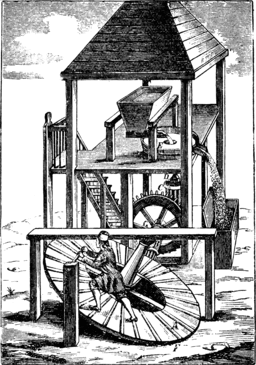Does it seem like work when you’re on a treadmill? There may be a good reason why – as in how tread wheels evolved into treadmills.
Ancient Greeks invented the crane to lift heavy loads in the late sixth century. Roman engineers took the Greeks’ design and built the Polyspastos Crane. The new crane allowed four workers to lift 3000kg using a winch on each side. The engineers then replaced the winch with the treadwheel (vertically attached to the crane). A worker would crawl inside the wheel (think hamster) allowing half the number of workers to lift double the weight due to the wheel’s larger diameter. The treadwheel would be used up until the 1900’s.

Human-powered treadmill for grinding grain (source: Wikipedia)
In the early 1800’s tread wheels were being used on farms and in mills. The wheel, people or animal powered, rotated (vertically like a water wheel or horizontally on a slight incline) on an axle replacing wind or water power. It could be used to churn butter, grind grain, pump water, or knead dough.
In 1818 the evolution of the treadwheel to the treadmill continued. British engineer Sir William Cubitt wanted to reform prisoners who he felt were too idle. He designed the Everlasting Staircase to punish the men for their inactivity. The manpower would be used to pump water or crush grain for mills. The machine required inmates to take more than 6,000 grueling vertical steps over eight hours at a very monotonous pace. Six years later it was also being used in New York prisons to tame defiant convicts. Cubitt’s treadmill continued in use even though the grinding repetitive stepping caused numerous prisoner revolts.
After years of use, American wardens stopped its use and replaced it with backbreaking tasks such as picking cotton, breaking rocks, or laying bricks. In England, the Prisons Act of 1898 finally ended its use there.
By the 1920s wealthy people customized wooden slat treadmills to lose unwanted weight gains (too much alcohol consumption). The slats rotated manually around two rolling drums. In the next decade the treadmills were set on an incline and later a fabric running belt replaced the slats.
In 1952, University of Washington cardiologist Dr. Robert A. Bruce first used a treadmill to test a patient’s cardiac and lung function while exercising. After attaching an electrocardiogram (EKG or ECG) to the patient, he had them run on a treadmill.
A home treadmill became a reality in 1969 when William Staub, a mechanical engineer, read about the benefits of running in Dr. Kenneth H. Cooper’s book Aerobics. He designed an affordable prototype and sent it to Dr. Cooper. That treadmill – the PaceMaster 600 – allowed even non-athletes to gain the health benefits of exercise.
